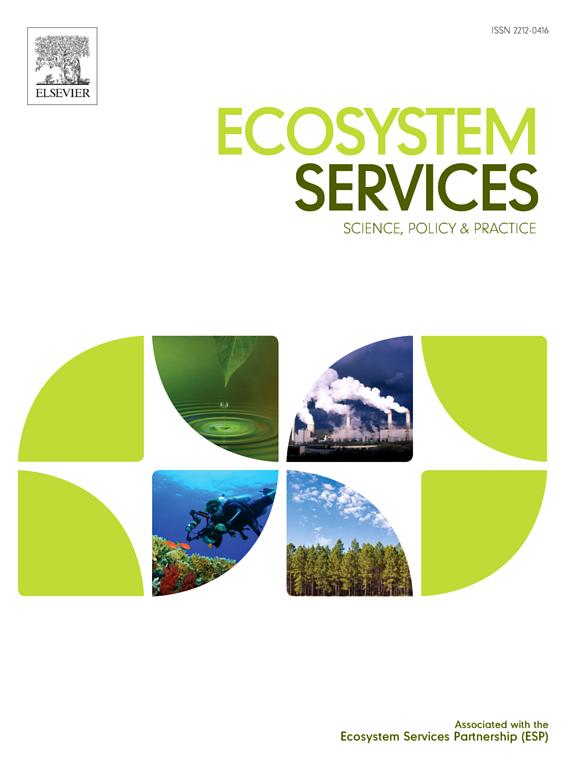衡量亚马逊森林的自然资本:以巴西Carajás国家森林为例
IF 6.6
2区 环境科学与生态学
Q1 ECOLOGY
引用次数: 0
摘要
我们提出了一种创新的方法,将自然和人联系起来,以评估亚马逊热带森林的自然资本。我们的研究地点是东亚马逊森林内的一个保护区,在那里我们定义了14个采样点,并分析了10个组成部分,其中包括现存森林的维护(自然本身)和生态系统服务的提供(自然对人)。生态系统功能评价采用5个分量,生态系统服务评价采用5个分量。在生态系统功能方面,动物467种(蜜蜂122种,蝴蝶53种,鸟类292种),植物418种,平均相互作用多样性为2.8(480种蜂-植物相互作用)。基于功能特征,我们发现至少83%的物种必须被保留以保证恢复力,而功能多样性依赖于60%的不可替代物种。11%的鸟类和9%的植物濒临灭绝。在生态系统服务功能方面,土壤和植被的碳储量平均分别为41.6和173 MgC/ha。据报道,亚马逊传统社区对42%的植物有一到四种利用。在保护区附近,我们发现66%的作物(20种作物中的13种)依赖传粉蜜蜂,每年作物授粉服务的价值为4.5亿美元。关于水保护和当地气候调节,数据建模显示,保护林的存在导致蒸散量增加21%,温度降低0.4℃。我们的框架显示了亚马逊热带森林中发现的巨型多样性与为人类福利提供的强大利益之间的明确联系,突出了森林保护是可持续发展的关键要素。对森林价值的认识取得进展,为提高森林养护和管理政策和决策的效力和效率提供了重要的新机会。本文章由计算机程序翻译,如有差异,请以英文原文为准。
Measuring the natural capital of Amazonian forests: A case study of the National Forest of Carajás, Brazil
We propose an innovative approach that links nature and people to assess the natural capital of tropical forests in the Amazon. Our study location is a protected area inside Eastern Amazon forest, where we defined 14 sampling points and analyzed ten components, which encompass the maintenance of standing forests (nature to itself) and the provision of ecosystem services (nature to people). Five components were used to assess ecosystem functions and five components were used to assess ecosystem services. As for ecosystem functions, we registered 467 species of animals (122 bees, 53 butterflies, 292 birds) and 418 plant species, and a mean interaction diversity of 2.8 (from 480 bee-plant interactions). Based on functional traits, we found that at least 83 % of species must be preserved to guarantee resilience, and that functional diversity relies on 60 % of non-replaceable species. Eleven per cent of birds and 9 % of plants are endangered. As for ecosystem services, carbon storage in soil and vegetation is 41.6 and 173 MgC/ha (on average), respectively. One to four uses by Amazonian traditional communities were reported on 42 % of plants. In the vicinities of the protected area, we found that 66 % of crops (13 from 20 crop species) depend on pollinating bees, and the value of annual crop pollination service is US$4.5Mi. Regarding water protection and local climate regulation, data modelling has shown that the presence of protected forests leads to a 21 % increase in evapotranspiration and a decrease in temperature of 0.4 °C. Our framework showed a clear link between the megadiversity found in Amazonian tropical forest and the robust benefits provided to human welfare, highlighting forest conservation as a key element for sustainable development. Advances in understanding the value of forests stimulate significant new opportunities to improve the effectiveness and efficiency of forest conservation and management policies and decision-making.
求助全文
通过发布文献求助,成功后即可免费获取论文全文。
去求助
来源期刊

Ecosystem Services
ECOLOGYENVIRONMENTAL SCIENCES&-ENVIRONMENTAL SCIENCES
CiteScore
14.90
自引率
7.90%
发文量
109
期刊介绍:
Ecosystem Services is an international, interdisciplinary journal that is associated with the Ecosystem Services Partnership (ESP). The journal is dedicated to exploring the science, policy, and practice related to ecosystem services, which are the various ways in which ecosystems contribute to human well-being, both directly and indirectly.
Ecosystem Services contributes to the broader goal of ensuring that the benefits of ecosystems are recognized, valued, and sustainably managed for the well-being of current and future generations. The journal serves as a platform for scholars, practitioners, policymakers, and other stakeholders to share their findings and insights, fostering collaboration and innovation in the field of ecosystem services.
 求助内容:
求助内容: 应助结果提醒方式:
应助结果提醒方式:


